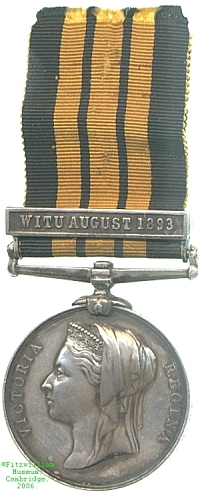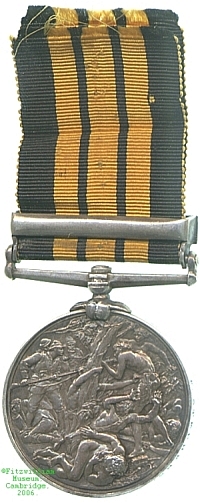
Obverse, a bust of Queen Victoria with crown and veil

Reverse, a scene of bush fighting around a tree with a fallen African to the fore

Obverse, a bust of Queen Victoria with crown and veil |

Reverse, a scene of bush fighting around a tree with a fallen African to the fore |
Peace-keeping operations in the British possessions in Africa, as anywhere else, required a large number of small campaigns, several of which, from 1892 until 1900, were considered to merit this medal, which in terms of design is a continuation of the Ashantee War Medal. Recipients who held that medal already were therefore awarded only extra clasps.
Witu was a small state in what is now Kenya. Established in 1858 as a colony of the Sultanate of Pate, it had come under British supervision after the Heligoland-Zanzibar Treaty of 1890 saw Germany renounce a short-lived Protectorate there to the British East Africa Company, subsequent unrest being suppressed in a campaign by the Royal Navy and the Sultan of Zanzibar. In 1891, however, a new Sultan, Fumo Umar ibn Ahmad, succeeded, and his actions were considered less than helpful by the British. As a result, a small punitive expedition was sent in 1893, which landed at the island town of Lamu in the Sultan's home state of Pate (now also in Kenya). Fumo Umar was briefly deposed, but returned to the throne in 1895.
This medal was awarded to Shipwright F. Stephens, who served in HMS Blanche, one of the three vessels from which the expedition was landed. Lester Watson purchased the medal from the London dealers Spink at some point before 1928.